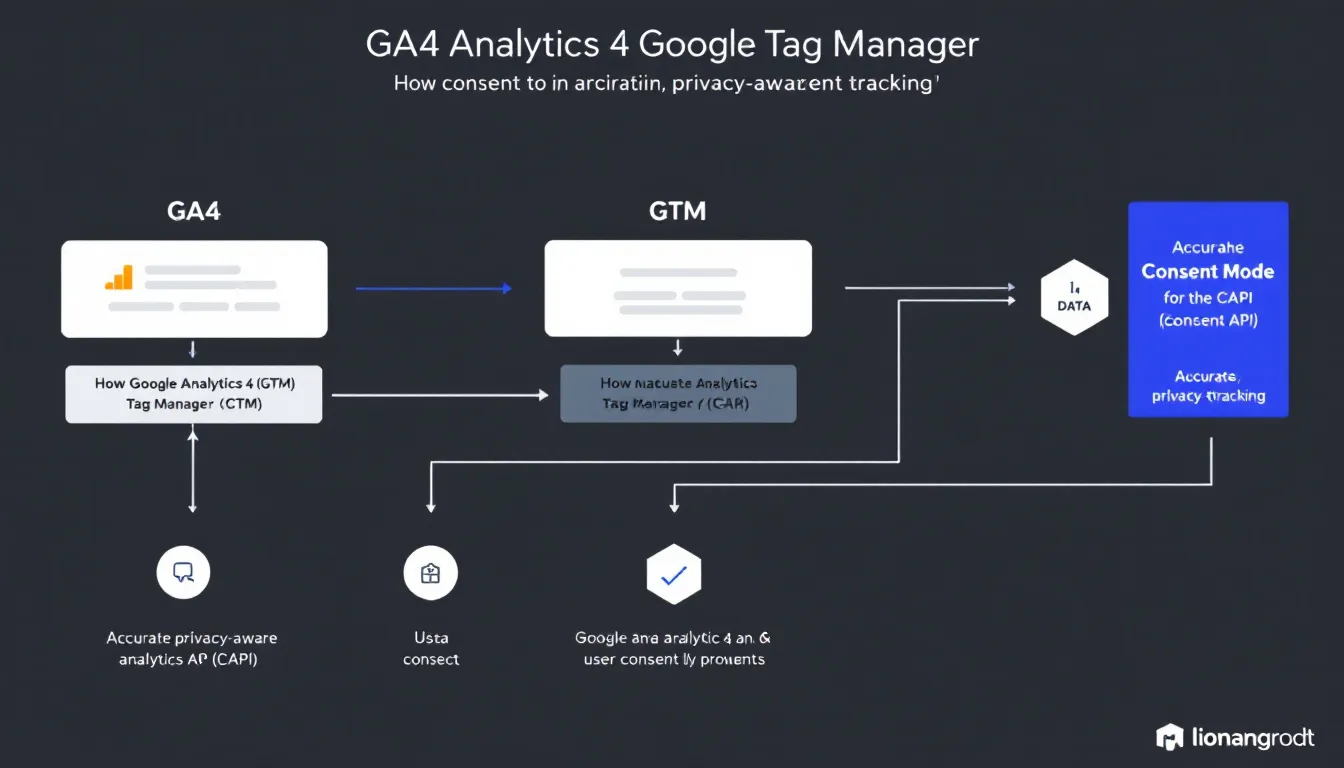Web, SEO & Data | The Ultimate Foundation for Growth
Building Your Data Foundation for Measurement: The Blueprint for Digital Marketing Success
In the complex world of digital marketing, success isn't just about driving traffic or creating compelling content, it's about understanding what works, what doesn't, and why. The foundation of this understanding lies in having a robust data measurement system that captures every interaction, conversion, and customer journey touchpoint with precision and reliability.
Setting up the right data foundation for measurement isn't just a technical necessity; it's the cornerstone that transforms guesswork into strategy, assumptions into insights, and marketing spend into measurable ROI. Without proper pixels, tags, and tracking mechanisms in place, even the most brilliant marketing campaigns become shots in the dark.
Why Your Data Foundation Matters More Than Ever
The digital marketing landscape has become increasingly sophisticated, with customers interacting across multiple touchpoints before making purchasing decisions. Today's consumers might discover your brand through social media, research on Google, compare prices on your website, and finally convert through a mobile app or in-store visit. User behavior metrics, including bounce rate and time spent on page, provide valuable insights into how visitors engage with your content during these interactions.
Without a comprehensive data foundation, you're missing critical pieces of this customer journey puzzle. Poor tracking leads to misattributed conversions, wasted ad spend on underperforming channels, and missed opportunities to optimize high-performing campaigns. Most importantly, it leaves you unable to prove the true value of your marketing investments to stakeholders.
Our Complete Web, SEO & Data Foundation Products
Building a robust data foundation requires more than just analytics tools, it demands a comprehensive approach that combines high-converting website infrastructure, trustworthy data collection, search engine optimization, and testing capabilities. Our integrated product suite addresses each critical component:
Product 1: Higher Conversion Rate Optimization
Fast, CRO-Led Landing Pages and Shopify Best-Practice Builds
Your website serves as both the foundation for data collection and the conversion engine for your business. Our conversion rate optimization product focuses on creating lightning-fast, strategically designed landing pages that not only capture accurate user behavior data but also maximize the likelihood of conversion.
Key features:
-
Speed-optimized landing pages that load in under 3 seconds, reducing bounce rates and improving data quality
-
CRO-driven design principles including strategic placement of call-to-action buttons, social proof elements, and trust signals
-
Mobile-first responsive builds ensuring consistent performance across all devices and accurate cross-platform tracking
-
Shopify best-practice implementations for e-commerce stores, including optimized checkout flows and product page structures
-
Conversion funnel optimization with clear tracking points at each stage of the customer journey
This foundation ensures that every visitor interaction is captured accurately while maximizing the conversion potential of your traffic investment.
Product 2: Trustworthy Data Collection
GA4 + GTM + CAPI with Consent Mode for Accurate, Privacy-Aware Tracking
Reliable decision-making requires reliable data. Our comprehensive tracking implementation creates a bulletproof measurement system that captures complete customer journeys while respecting privacy regulations and user preferences.
Implementation includes:
-
Google Analytics 4 (GA4) setup with advanced e-commerce tracking, custom events, and cross-platform user journey mapping
-
Google Tag Manager (GTM) configuration providing centralized tag management without slowing down your website
-
Conversion API (CAPI) integration ensuring accurate attribution despite iOS updates and cookie restrictions
-
Consent Mode implementation maintaining data insights while respecting user privacy choices and regulatory compliance
-
Enhanced measurement features including scroll tracking, video engagement, and file download monitoring
-
Data quality assurance with filtering rules to exclude spam traffic and internal visits
This system provides the trustworthy data foundation necessary for confident marketing decisions and campaign optimization.
Product 3: SEO That Compounds Over Time
On-Page, Technical, and Local Improvements That Reduce Reliance on Paid Advertising
While paid advertising delivers immediate results, organic search traffic builds sustainable, long-term growth that compounds over time. Our SEO optimization product creates search visibility that reduces your dependence on paid channels while improving overall website performance.
Our SEO approach includes:
-
Technical SEO optimization including site speed improvements, mobile responsiveness, and structured data markup
-
On-page SEO enhancements with keyword optimization, content structure improvements, and meta tag optimization
-
Local SEO implementation for businesses serving specific geographic areas, including Google My Business optimization
-
Search console integration providing insights into organic performance and keyword opportunities
-
Content strategy development based on search demand and user intent analysis
-
Link building and authority development to improve domain strength and search rankings
This compound approach builds organic traffic that grows stronger over time, reducing your cost per acquisition and creating sustainable competitive advantages.
Product 4: A/B Testing Infrastructure
Clear Hooks for Testing Offers, Headlines, and Layouts Without Development Overhead
Continuous optimization requires the ability to test and iterate quickly. Our A/B testing infrastructure product creates the technical foundation for rapid experimentation without requiring developer resources for every test.
Testing capabilities include:
-
Visual editor integration allowing non-technical team members to create and deploy tests
-
Statistical significance tracking ensuring test results are reliable and actionable
-
Multi-variant testing support for complex optimization scenarios involving multiple page elements
-
Audience segmentation enabling targeted tests for specific customer segments or traffic sources
-
Goal and conversion tracking measuring the impact of tests on revenue, leads, and other business objectives
-
Results reporting and insights with clear recommendations for implementation and scaling
This infrastructure enables data-driven optimization that continuously improves performance across all marketing channels and customer touchpoints.
Setting Up Your Tracking Architecture
Website Foundation: Fast, Conversion-Optimized Pages
Your data foundation starts with website performance. Fast-loading, conversion-rate-optimized (CRO) landing pages provide the technical foundation for accurate tracking while delivering superior user experiences that drive conversions.
Key elements include:
-
Mobile-first responsive design that works seamlessly across all devices
-
Page speed optimization reducing bounce rates and improving data quality
-
Clear conversion paths with properly tagged buttons and forms
-
CRO best practices including compelling headlines, social proof, and streamlined checkout processes
For Shopify stores specifically, implementing platform best practices ensures your e-commerce tracking captures complete customer journey data, from product views to final purchase confirmation.
Technical SEO: The Invisible Foundation
Technical SEO improvements don't just boost search rankings; they create a solid foundation for accurate data collection. When search engines can easily crawl and understand your site, your analytics tools can too. Site speed is considered one of the main SEO factors contributing to overall user experience and SERP rank, making it a critical area of focus for technical optimization. High-quality backlinks from reputable sites are a strong signal of authority to search engines, further enhancing your site's credibility and ranking potential. Additionally, click-through rate (CTR) measures the percentage of users who click on a search result after seeing it, serving as a key indicator of how well your content resonates with searchers.
Critical technical elements:
-
Structured data markup helping search engines understand your content and products
-
XML sitemaps ensuring all important pages are discovered and tracked
-
Clean URL structures improving both SEO and analytics reporting
-
Fast site speed reducing data loss from user abandonment
-
Core Web Vitals metrics established by Google for measuring loading speed, interactivity, and visual stability, which are essential for both user experience and search rankings
A/B Testing Infrastructure: Data-Driven Optimization
Building your site with clear testing hooks allows for continuous optimization without requiring developer resources for every experiment. This infrastructure enables rapid testing of offers, headlines, layouts, and user experiences.
Testing capabilities include:
-
Split testing different landing page variants to optimize conversion rates
-
Dynamic content personalization based on user behavior and preferences
-
Multivariate testing for complex optimization scenarios
-
Statistical significance tracking ensuring test results are reliable and actionable
Who Benefits from This Data Foundation Approach
Our comprehensive web, SEO, and data foundation products serve a diverse range of businesses that depend on paid media campaigns, digital visibility and conversion optimization:
E-commerce and Lead Generation SMEs across multiple industries including:
-
Retail businesses tracking product performance and customer acquisition costs
-
Beauty brands measuring social proof impact and repeat purchase behavior
-
Food & drink companies optimizing local search and seasonal demand patterns
-
Trade businesses capturing "near me" searches and service area optimization
-
Real estate professionals tracking lead generation and local market visibility
-
Car dealerships measuring inventory visibility and lead conversion rates
-
Healthcare practices optimizing appointment bookings and local search presence
-
Education providers tracking enrollment funnels and program interest
-
Hospitality businesses measuring booking conversions and seasonal patterns
-
SaaS companies optimizing trial signups and subscription conversions
-
Professional services tracking consultation requests and client acquisition
-
Franchise operations managing multi-location visibility and performance
Each industry benefits from tailored measurement approaches that capture their specific customer journeys, seasonal patterns, and conversion goals while building the organic visibility that reduces long-term marketing costs.
Measuring Success: Key Performance Indicators
Conversion Rate Optimization Metrics
Your data foundation should clearly track how website improvements impact conversion rates across different traffic sources and user segments.
Critical CRO metrics:
-
Overall conversion rate and segment-specific performance
-
Average order value trends and optimization opportunities
-
Time to conversion understanding customer decision timelines
-
Form completion rates identifying friction points in lead generation
-
Conversion rate measures the percentage of visitors completing desired actions, such as purchases or form submissions, making it a key indicator of marketing effectiveness.
-
Overall conversion rate and segment-specific performance
-
Average order value trends and optimization opportunities
-
Time to conversion understanding customer decision timelines
-
Form completion rates identifying friction points in lead generation
Attribution and Channel Performance
Understanding which marketing channels drive valuable customers allows for intelligent budget allocation and campaign optimization.
Essential attribution insights:
-
First-click attribution showing how customers discover your brand
-
Last-click attribution identifying closing channels
-
Multi-touch attribution revealing the complete customer journey
-
Assisted conversions understanding channel collaboration
ROI and Revenue Impact
Your measurement system should clearly demonstrate the financial impact of marketing investments across all channels and campaigns.
Revenue tracking includes:
-
Return on ad spend (ROAS) for paid advertising channels
-
Customer acquisition cost (CAC) across different marketing methods
-
Customer lifetime value (CLV) for long-term profitability assessment
-
Marketing contribution to revenue showing overall impact
Building for Long-Term Growth
The Power of Search Engine Optimization in Your Data Foundation
Search engines serve as the gateway through which users discover your business across the digital landscape. A robust data foundation not only tracks these discovery moments but helps optimize them for maximum impact. Organic traffic data reveals how often users visit a website through unpaid search results, providing valuable insights into the effectiveness of your SEO efforts and content strategies. Engagement signals, such as likes and shares on social media, can further amplify brand exposure and drive referral traffic, enhancing the overall impact of your digital presence.
Organic Traffic Development Through Strategic SEO
A strong data foundation enables you to identify and capitalize on organic growth opportunities that reduce reliance on paid advertising over time. This approach requires combining technical SEO excellence with data-driven insights to create a self-reinforcing cycle of improved visibility and performance.
Organic growth strategies include:
-
Keyword research and optimization using tools like Google Keyword Planner to identify high-value search terms your audience treasures, including analyzing keyword monthly search volume to prioritize efforts. Keyword monthly search volume represents the number of searches a keyword receives over a month.
-
Content performance analysis showing which topics drive engagement and conversions while analyzing search intent
-
Technical SEO monitoring through regular audits ensuring web crawlers can access and index your content efficiently
-
Search console integration providing insights into keyword rankings and organic traffic patterns
-
Local SEO measurement for businesses with physical locations, improving local search visibility
-
Backlink analysis tracking link-building efforts and identifying broken links that could impact authority
-
Structured data implementation helping search engines understand your content and improve SERP appearance
-
Iterative optimization to continuously refine SEO strategies based on performance data and emerging trends
-
Consistently high rankings and engaging content contribute to building brand authority and trust, which are essential for long-term success.
-
Keyword research and optimization using tools like Google Keyword Planner to identify high-value search terms your audience treasures
-
Content performance analysis showing which topics drive engagement and conversions while analyzing search intent
-
Technical SEO monitoring through regular audits ensuring web crawlers can access and index your content efficiently
-
Search console integration providing insights into keyword rankings and organic traffic patterns
-
Local SEO measurement for businesses with physical locations, improving local search visibility
-
Backlink analysis tracking link-building efforts and identifying broken links that could impact authority
-
Structured data implementation helping search engines understand your content and improve SERP appearance
How Data Foundation Helps You Grow with Organic Search Traffic
Your measurement system should demonstrate how SEO efforts translate into business growth across multiple dimensions:
Improves ROI of Every Traffic Source By properly tracking and optimizing conversion paths, your data foundation helps convert more visitors regardless of how they arrive at your site. Whether traffic comes from organic search, paid search, or social media, optimized landing pages and clear conversion funnels maximize the value of every visitor.
Reveals True Winning Channels and Creatives Comprehensive attribution modeling shows which search terms, content pieces, and traffic sources deliver the highest-value customers. This insight allows you to scale successful strategies with confidence while eliminating waste from underperforming efforts.
Builds Durable Organic Traffic and Local Visibility Over Time Unlike paid advertising that stops when budgets end, SEO creates compound growth that strengthens over time. Your data foundation tracks this progression, showing how technical improvements, content optimization, and local SEO efforts build sustainable visibility that reduces long-term acquisition costs.
SEO Analytics and Performance Measurement
Successful SEO requires continuous monitoring using specialized analytics tools that integrate with your broader measurement framework:
Google Search Console Integration Track keyword rankings, click-through rates, and search performance data that reveals optimization opportunities and measures the impact of SEO efforts on organic visibility.
SEO Analytics Tools Comprehensive SEO analytics provide insights into technical issues, content performance, and competitive positioning that inform ongoing optimization strategies.
Backlink Profile Monitoring Track link-building efforts and identify opportunities for earning high-quality backlinks that improve domain authority and search engine rankings.
Competitive Intelligence
Your data foundation can provide insights into competitive positioning and market opportunities through search and social listening integration.
Competitive analysis capabilities:
-
Share of voice measurement in search results and social media
-
Keyword gap analysis identifying opportunities competitors miss
-
Content performance comparison understanding what resonates in your market
-
Local search visibility tracking against local competitors
-
Competitor SEO data analysis to uncover content gaps and new opportunities for growth
-
Share of voice measurement in search results and social media
-
Keyword gap analysis identifying opportunities competitors miss
-
Content performance comparison understanding what resonates in your market
-
Local search visibility tracking against local competitors
Implementation Best Practices
Phase 1: Foundation Setup
Start with core tracking implementation ensuring accurate data collection across your most important conversion paths.
Initial priorities:
-
GA4 and GTM implementation with proper configuration
-
Enhanced e-commerce tracking for revenue attribution
-
Conversion API setup for primary advertising platforms
-
Consent Mode implementation for privacy compliance
Phase 2: Enhancement and Integration
Build upon your foundation with advanced tracking and third-party integrations that provide deeper insights.
Enhancement activities:
-
CRM integration for complete customer journey tracking
-
Advanced audience creation for remarketing optimization
-
Custom event tracking for specific business actions
-
Attribution modeling setup for multi-channel analysis
Phase 3: Optimization and Scaling
Use your established data foundation to drive continuous improvement and strategic growth decisions.
Optimization focus areas:
-
A/B testing program implementation and management
-
Predictive analytics for customer behavior forecasting
-
Advanced segmentation for personalized marketing
-
ROI optimization across all marketing channels
Common Pitfalls and How to Avoid Them
Data Quality Issues
Poor data quality undermines even the most sophisticated analysis. Common issues include duplicate tracking, incorrect goal setup, and spam traffic inclusion. By analyzing technical SEO data, you can uncover issues that may hinder search engine visibility and user experience, ensuring your site performs optimally for both users and search engines. SEO performance tracking ensures continuous improvement and better return on investment for digital marketing efforts, making it an essential part of your strategy.
Data quality solutions:
-
Regular audit procedures to identify and fix tracking issues
-
Proper filtering to exclude internal traffic and spam
-
Validation processes ensuring data accuracy
-
Documentation maintaining tracking implementation consistency
Privacy and Compliance Oversights
Failing to properly implement privacy-compliant tracking can result in legal issues and data collection limitations.
Compliance best practices:
-
Regular privacy policy updates reflecting current tracking methods
-
User consent management respecting opt-out preferences
-
Data retention policies aligned with regulatory requirements
-
Staff training on privacy-compliant data handling
Attribution Model Limitations
Using only last-click attribution significantly undervalues upper-funnel marketing activities and channels.
Attribution improvements:
-
Multi-touch attribution modeling showing complete customer journeys
-
Channel interaction analysis revealing collaborative effects
-
Time-decay models giving appropriate credit to all touchpoints
-
Custom attribution models tailored to specific business models
Your Path to Measurement Excellence
Building a comprehensive data foundation for measurement isn't just about implementing tracking codes, it's about creating a system that transforms data into actionable insights that drive business growth. When properly implemented, your measurement foundation becomes a competitive advantage that compounds over time.
The businesses that thrive in today's data-driven marketing environment are those that invest early in robust measurement systems. They understand that every dollar spent on proper tracking infrastructure returns many times over through improved campaign performance, better customer understanding, and more efficient marketing spend allocation.
Whether you're running an e-commerce store, professional services firm, or local business, the principles remain the same: accurate data collection, comprehensive attribution modeling, and continuous optimization based on reliable insights.
Start with the fundamentals, GA4, GTM, and Conversion API, then build systematically toward more sophisticated measurement capabilities. Your future marketing success depends on the data foundation you build today.
The question isn't whether you can afford to invest in proper measurement, it's whether you can afford not to. In a world where customer acquisition costs continue rising and privacy restrictions tighten, businesses with superior data foundations will capture the greatest share of available growth opportunities.
Build your measurement foundation right, and watch as guesswork transforms into strategy, waste transforms into efficiency, and marketing spend transforms into predictable, scalable business growth.
Conclusion
Building a strong data foundation is essential for any digital marketing strategy aiming for long-term success. By integrating fast, conversion-optimized websites with trustworthy data collection methods and robust SEO practices, businesses can unlock valuable SEO insights that drive organic growth and improve overall search engine rankings. Leveraging tools like Google Analytics, Google Search Console, and specialized SEO tools enables marketers to monitor performance, identify opportunities, and continuously optimize their strategies based on real search behavior and user intent. With a comprehensive approach that combines technical SEO audits, backlink data analysis, keyword analytics, and content optimization, your website's online performance will improve steadily, reducing reliance on paid advertising and creating sustainable competitive advantages. Investing in a solid data foundation today sets the stage for measurable ROI, enhanced user experiences, and enduring digital visibility in search engine results pages.
Frequently Asked Questions (FAQs)
What is SEO data and why is it important?
SEO data refers to the information collected and analyzed to improve a website's visibility and ranking on search engine results pages (SERPs). It includes metrics like keyword rankings, organic traffic, backlink profiles, and technical SEO health. This data is crucial because it helps businesses optimize their online presence, understand user behavior, and make informed decisions to enhance search engine optimization efforts.
How do search engines like Google use SEO data?
Search engines like Google use SEO data to evaluate and rank web pages based on relevance and authority. They rely on search engine algorithms that analyze factors such as keyword usage, inbound links, site speed, and content quality to determine how well a web page matches users' search queries. Proper SEO data helps ensure that search engines understand your content and display it prominently in organic search results.
What are the main types of SEO data?
The main types of SEO data include:
-
Keyword data: Information about the keywords users search for and their monthly search volume.
-
Backlink data: Details about inbound links from other websites and their quality.
-
Technical SEO data: Metrics related to site speed, crawlability, mobile-friendliness, and structured data.
-
Organic traffic data: Data on the number of visitors arriving through unpaid search results.
-
Conversion data: Information on how effectively a website converts visitors into customers.
How can I collect and analyze SEO data?
You can collect SEO data using tools like Google Search Console, Google Analytics, and specialized SEO analytics tools such as Ahrefs, SEMrush, or Moz. These platforms provide insights into keyword rankings, organic traffic, backlink profiles, and technical issues. Regular analysis of this data helps identify opportunities for optimization and track the effectiveness of your SEO strategy.
What role does technical SEO play in SEO data?
Technical SEO involves optimizing the technical aspects of a website to improve search engine crawling, indexing, and user experience. Technical SEO data includes site speed, mobile responsiveness, crawl errors, and structured data implementation. Analyzing and addressing technical SEO issues ensures that search engines can effectively access and rank your web pages, enhancing overall SEO performance.
How does backlink data influence SEO rankings?
Backlink data shows which other websites link to your site. High-quality backlinks from authoritative and relevant sites act as endorsements, signaling to search engines that your content is trustworthy and valuable. This can significantly boost your SEO rankings. Monitoring backlink data helps you build a strong link profile and identify potentially harmful links.
What is the difference between organic search results and paid search?
Organic search results are listings on search engine results pages that appear because of their relevance to the search query, without payment. Paid search results, such as Google Ads, are advertisements that appear at the top or bottom of the SERPs and require payment per click. SEO focuses on improving organic search rankings to attract free, sustainable traffic.
How often should I monitor and update my SEO data?
SEO data should be monitored regularly—ideally monthly or quarterly—to track performance trends, identify issues, and adjust strategies accordingly. Frequent updates allow you to respond quickly to changes in search engine algorithms, user behavior, and competitive landscapes, ensuring your SEO efforts remain effective.
Can SEO data help improve user experience on my website?
Yes, SEO data includes user behavior metrics such as bounce rate, time on page, and click-through rate. Analyzing these helps identify areas where visitors might be frustrated or disengaged. Improving these aspects enhances user experience, which can lead to higher engagement, better rankings, and increased conversions.
Who should manage SEO data within a company?
Typically, an SEO manager or digital marketing specialist oversees SEO data analysis and strategy implementation. They coordinate with content creators, web developers, and analytics teams to ensure that SEO efforts align with business goals and technical best practices.










